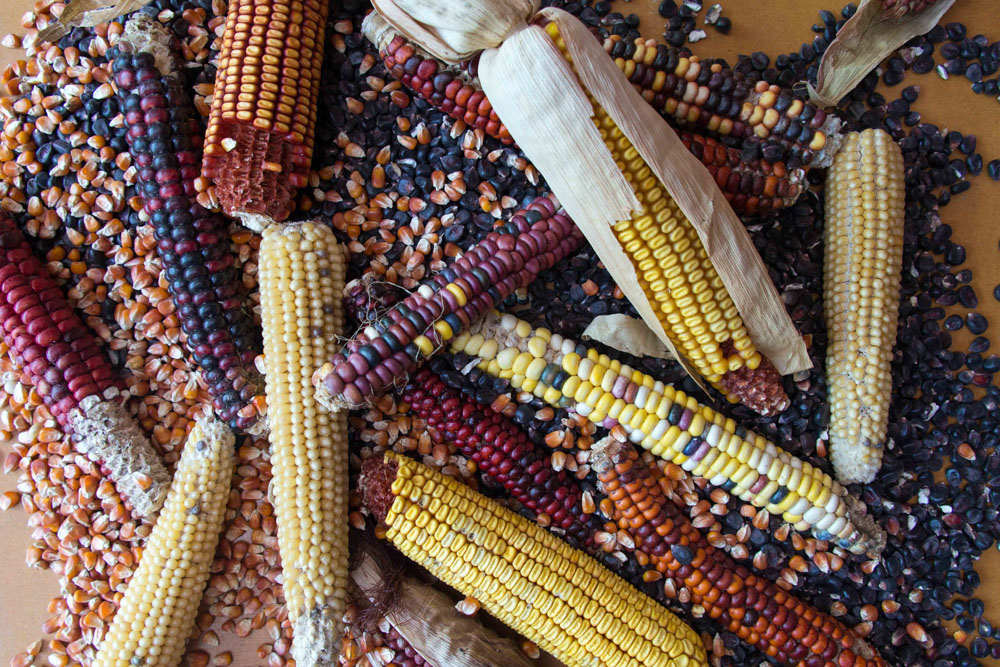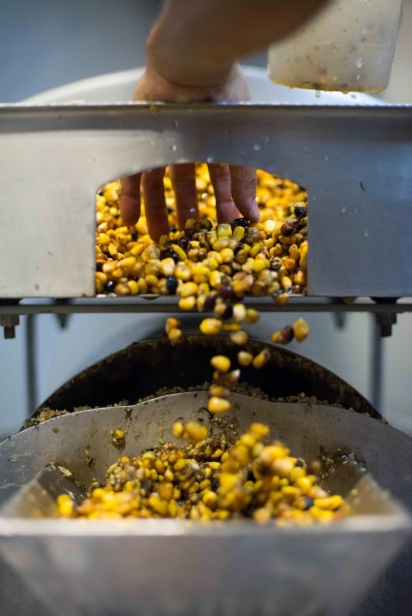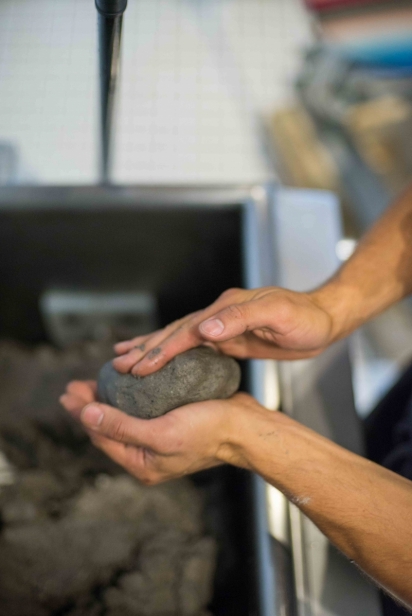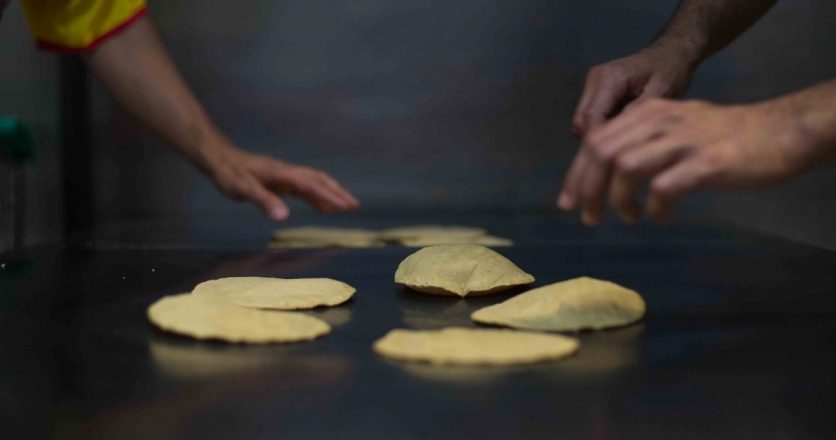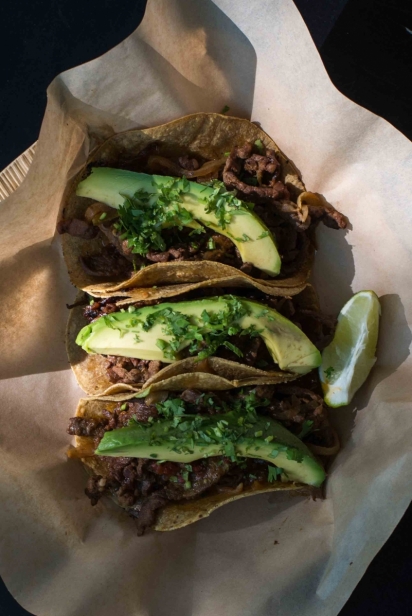Corn's Cultural Shift
It’s corn season in Canada. Sweet corn is piled at roadside stands across the Fraser Valley, and kids are racing through maize mazes, high as an elephant’s eye. We’re pulling golden cobs from boiling pots, served dripping with butter, at picnics across the nation, while chefs are riffing on corn recipes, adding the super-sweet kernels to risottos, velvety corn chowders and crunchy corn salads.
Charring, creaming, popping and grilling our favourite yellow and bicolour varieties, from peaches and cream to jubilee and krispy king corn, is the essence of summer, a delicious seasonal window Canadians await with anticipation.
The history of corn
But long before the first colonists learned to love corn, Indigenous people were cultivating the native crop with roots in the ancient Mayan, Aztec and Inca cultures. It subsequently spread across Indigenous cultures in the Americas centuries ago.
Historians note that when explorer Jacques Cartier arrived in 1535, he met corn-growing people along the St. Lawrence River. And in 1615, Samuel de Champlain found the Huron people growing fields of corn in Simcoe County (Huronia) along Georgian Bay.
In fact, corn has been grown by First Nations in Canada since 500 A.D., arriving in this region via trade routes.
It’s estimated that 30,000 Wendat people lived in the Huronia region in that period, cultivating 7,000 acres of corn, squash and beans (the famous Three Sisters crops), and trading their produce with other Indigenous nations for fur and meat. Much of this pre-contact commerce involved corn, a crop developed by Amerindian farmers in central America that spread south through central America to Peru, and north by the Hopi, Navajo and Iroquois people via river trade routes, and to Indigenous people along the St. Lawrence River and Great Lakes.
The Haudenosaunee — Six Nations or Iroquois confederacy, around the southern Great Lakes (what is now Southern Ontario, central New York State, Quebec and Pennsylvania) — were agricultural people with longhouses to hang and store dried corn. In one Seneca village, early colonists reported finding a million bushels of stored corn.
This Haudenosaunee white corn is central to the Iroquois creation story, too, a variety of long white cobs that can last up to 10 years when properly dried. The first British and French colonists in North America learned to grow corn from their Indigenous neighbours.
Today, there is a resurgence in growing traditional corn varieties in Indigenous communities, slaking the dried kernels with wood ash to create ground cornmeal for hominy, corn bread and, in Mexico and points south, tortillas and tamales.
Multi-coloured Indian (flint) or yellow and white (dent) corn is finding new fans for making corn flour and cornmeal, too.
Modern corn cultivation
It’s hard to pinpoint exactly when Canadian farmers began to focus almost exclusively on sweet corn for seasonal fresh markets and feed corn for animals and biofuel, but growing heirloom varietals of corn as a grain for milling is now rare.
Today, sweet corn is grown across B.C., from Vancouver Island and the Lower Mainland to the Okanagan Valley. Forage or silage corn for livestock is actually a much larger crop — the majority of corn grown in B.C. is used for livestock forage rather than as a grain crop for cornmeal or cornflour.
Jordan Marr of Unearthed Organics in Kelowna is one small farmer who’s bucking that trend. A market gardener selling his fresh greens and vegetables to local chefs, Marr began growing colourful blue and painted mountain corn as a lark — varieties Canadian seed companies often sell to gardeners as “ornamental.”
Marr says he was stunned by the fresh flavour when he started experimenting with grinding the various varieties of the corn he had planted. Five years on, he’s now selling three or four different types of dried corn and cornmeal, direct to chefs and consumers in B.C.
“The first time I used my own home-grown cornmeal in a recipe, I couldn’t believe what I tasted,” says Marr. “Freshly milled corn, using corn varieties bred for flavour, is a revelation, and is nothing like what you find in the grocery store.”
Marr has experimented with several varieties of corn, saving the open-pollinated seed to select for size, colour and early ripening. This year, a new selection he is planting is Montana Morado maize, an inky blue corn, named for the variety used for the lightly fermented Chicha Morada beverage in Peru, but developed in Montana, an earlier ripening variety descended entirely from American breeds.
With successive plantings and seed selections, Marr says he may someday even have his own Okanagan-centric variety of corn for milling, but for now, it’s the nothstine dent, Jerry Petersen blue and Roy’s Calais flint he’s selling to gardeners and to chefs and bakers for their polenta, cornbread, muffins and tortillas. Even the white and black popping corn he grows makes tasty cornmeal and flour, he says, when stoneground in a home mill.
Because it’s a whole grain, with the germ intact (unlike the more common commercial cornmeal you can buy), his cornmeal is not shelf stable and should be stored in the freezer. You can buy Marr’s milling corn or freshly milled cornmeal, direct from the farm in Kelowna ($5 per pound of whole grain or for a 340- gram bag of cornmeal).
Fieldstone Organics is another source for B.C.-grown dried corn and cornmeal, selling organic dent corn grown in Western Canada that can be ground for polenta or corn f lour in a domestic mill.
Reviving ancient methods
The other side of the corn milling story that’s emerging in Canada comes directly from Mexico and Central America — the ancient method of nixtamalizing dried whole-grain corn before grinding it for fresh “masa” to make tortillas.
Most of us are used to tortillas made with corn f lour (the ubiquitous masa harina), but that’s a modern invention made on a large scale.
Nixtamalization of corn is a tradition that dates back 3,500 years. It was Aztec and Mayan people who discovered that soaking dried corn in an alkaline “slaked lime” (calcium hydroxide) solution, originally derived from ash, before cooking and grinding it for masa, releases nutrients and makes corn easier to digest.
It’s a tradition that was nearly lost, but one that a handful of dedicated chefs, such as Ernesto Gomez of Vancouver’s Alimentaria Mexicana and Chancho Tortilleria, and Israel Alvarez Molina of Victoria’s Maiiz, are keen to revive.
Both Mexican-born chefs embraced nixtamalization as a way to reconnect with their own heritage and highlight the superior taste and texture of a tortilla that’s made from whole grain corn, rather than processed flour. Molina likens it to serving real mashed potatoes, versus processed instant potatoes.
“To Mexican people, our culture, heritage and nutrition are ingrained with corn, but sadly it has been taken over by commercial interests,” says Alvarez Molina. “There are at least 58 different varieties of corn grown in Mexico today, but only one is used to mass produce industrial tortillas.”
While Alvarez Molina is making his tortillas with organic dent corn grown in B.C. and working with Indigenous growers to cultivate heirloom Iroquois corn here, Gomez has partnered with an NGO in Mexico to buy landrace corn directly from small farmers, to help keep the unique varieties alive “in their own ecosystems.”
Gomez began by nixtamalizing a wide selection of imported Mexican varieties at his Chancho Tortilleria in Vancouver (a sister restaurant and precursor to Alimentaria Mexicana), with the provenance of each varietal listed on a rotating board that changed daily, including the region, farm and elevation. He’s since simplified that system, but still updates his masa menu with different corn every few weeks.
At Alimentaria Mexicana, he’s joined with chef Martin Vargas and Darragh McFeely to build a larger restaurant and retail space on Granville Island. There’s an extensive Mexican menu at the cantina and a mercado offering a range of Mexican ingredients and cooking equipment, bags of Zapotec Amarillo or Mixteca Blanco Baja corn and the calcium hydroxide used for nixtamalizaton. There’s even a Maiz Essentials basket that also includes heirloom corn flour, corn husks and a tortilla press for home use.
At Maiiz, you can buy imported Mexican chilies and other ingredients, too, plus nixtamal tortillas, nixtamal masa dough by the pound and nixtamal hominy, ready for using in soups, stews and traditional pozole. And you’ll find Maiiz Nixtamal tortillas at several local retailers, and on a variety of city restaurant menus, from Saveur and Boom + Batten to Niche Grocerant and The Empress Hotel in Victoria.
Freer trade
Though Indigenous people introduced us to corn, we have hybridized it, genetically modified it, over-cropped it and turned it into feed for livestock and oil for frying fast food.
It was the first NAFTA agreement in the 1990s that allowed American industrial corn growers to flood the Mexican market with cheap, GMO corn products and push consumers there away from home-grown, landrace varieties of corn, even for their “daily bread” — the corn tortilla. In fact, it destroyed the livelihoods of many Mexican farmers, forcing them to leave the land and find urban jobs, or leave the country for seasonal farm work in Canada and the U.S.
Americans, meanwhile, are the kings of corn. It’s the largest cash crop in the U.S., the fields of dreams for generations of mid-west- ern settlers and, thanks to the wonders of science, now planted in almost every state, 15.1 billion bushels harvested in 2021.
But by keeping the rare and unique heirloom varieties of corn in circulation, we’re not only supporting small farmers, we’re also preserving genetic diversity in a grain crop that’s been essential to human existence for millennia.
Mexican scientists and farmer co-ops recently formed an association called ProMaiz Nativo, to help native maize and milpa farm families, creating a trademark and Milpaiz logo, to authenticate and certify the landrace varieties they grow.
In New York state, the Iroquois White Corn Project helped preserve an Indigenous strain of corn prized by local tribes for more than 1,000 years, with “tuscarora white” corn being since added to Slow Food USA’s Ark of Taste. By reintroducing heirloom corn into the diets of Indigenous people, the project hopes to end diet-related health issues, including diabetes.
Chefs Gomez and Alvarez Molina have expanded beyond their own restaurants, introducing consumers and other restaurant chefs to nixtamalized tortillas and landrace corn, with an eye to local and sustainable food systems.
And apparently, we’re all ready to move on beyond fast-food tortillas into artisan territory, too, as both of these chefs have been celebrated for their work with awards this year. Maiiz Nixtamal was named producer of the year and best Latin restaurant in the 2022 YAM magazine restaurant awards in Victoria this summer. Alimentaria Mexicana and Chancho Tortilleria are finalists in the best Latin American category for Vancouver Magazine’s restaurant awards, which will be announced in September.
“I feel the answers to save humankind exist within the ancestral knowledge of our First Nations, so I have dedicated my work to reconciling through food and in the traceability of our products,” Gomez says. “The abusive industrialization of foods is destroying our planet.”
Cooking heirloom corn
Of course, anyone who loves fresh corn on the cob knows it’s the distance between the field and the pot that makes the biggest difference in quality, as the sugars in sweet corn start turning to starches the minute it’s picked.
When it comes to dried, milled cornmeal, fresh is important, too, says Ned Bell of the Naramata Inn. Bell uses Marr’s fresh ground cornmeal for his Unearthed Farm’s Heritage Corn Escaoutoun — a creamy combination of cornmeal and mascarpone served with caramelized cabbage, roasted beets, squash and walnuts.
Marr also sells his dried heritage corn to chef Alden Ong at Farmer’s Apprentice in Vancouver, where you might find it in the creamed heirloom hominy paired with a wild mushroom conserva. At The Acorn, Chef Devon Latte uses Marr’s corn in his vegan menu, too, in dishes such as celeriac and heritage corn grits, with fermented serrano, pearl oyster mushrooms and remoulade.
But less ambitious home cooks might try freshly milled whole cornmeal in simple corn pancakes, cornbread, fritters or the classic cornmeal porridge (aka Italian polenta, Ukrainian mamaliga, Mexican atole or cornmeal mush).
And should you simply want to indulge in a feast of fresh sweet corn, place shucked cobs in a large pot of cold water with a pinch of sugar, bring to a boil, cover the pot, cook barely one minute more, drain well and slather with butter, season with salt and serve.
Corn season — it’s the most wonderful time of the year.
Unearthed Organics
2424 Mayer Rd., Kelowna, B.C. | 250.767.6636
unearthedfarm.com | @unearthedfarm
Alimentaria Mexicana
1596 Johnston St., Granville Island, Vancouver, B.C. 236.521.8438
alimentariamexicana.com | @alimentariamexicana
Chancho Tortilleria
560 Davie St., Yaletown, Vancouver, B.C. | 604.336.9219
chancho.ca | @chanchotortilleria
Maiiz Nixtamal
540 Fisgard St., Victoria, B.C. | 778.433.1544
maiiz.ca | @maiiz.nixtamal


